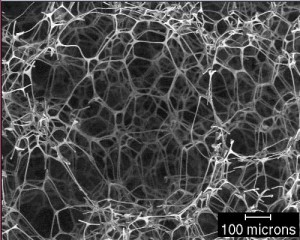We have just nought a product marketed in Australia by Chux called Magic Eraser. The product is a melamine foam. Chux claims that the product is non-toxic. They claim
- The CHUX® Magic Eraser® is a melamine foam which has superfine eraser-like fibres that easily lift and trap dirt.
- The CHUX® Magic Eraser® is chemical and detergent free and actually performs a ‘mechanical’ clean.
I was curious to find out more, as the product wears fairly quickly and could produce a deal of fibres that may be toxic. A Wiki gives some background on its development and use. Nestor_Kelebay notes in a blog
“BASF of Germany makes a foam called “Basotect” that was originally used in airplane seat cushions because it wouldn’t burn. It’s still used to make shoulder pads for men’s and women’s clothing. A Magic Eraser is nothing more than a piece of Basotect foam. This is what Basotect foam looks like when viewed under an electron microscope:  If the electron micrograph is representative of the Magic Eraser found in Australia, then it is possible that some of the fibres released during use could be categorised as respirable fibres – short and less than 3 microns diameter. Some may be termed nanofibres and the toxicity of these fibres may be very different from that of coarser melamine fibres. The fineness of the dust could mean little dust is deposited in the nose or throat, making inhalation of the fibres not unpleasant, so users could be oblivious of any toxic exposure.
If the electron micrograph is representative of the Magic Eraser found in Australia, then it is possible that some of the fibres released during use could be categorised as respirable fibres – short and less than 3 microns diameter. Some may be termed nanofibres and the toxicity of these fibres may be very different from that of coarser melamine fibres. The fineness of the dust could mean little dust is deposited in the nose or throat, making inhalation of the fibres not unpleasant, so users could be oblivious of any toxic exposure.
The BASF MSDS (2007) for Basotect notes (for 2500mm x 1250mm x 500mm blocks):
- Use: Open cell foam blocks for the production of sound and thermal insulation for the building and motor industries.
- Avoid dust formation. Processing machines must be fitted with local exhaust ventilation
- Respiratory protection: Breathing protection if dusts are formed.
- Assessment of sensitization: A sensitizing effect on particularly sensitive individuals cannot be excluded.
I could not find any studies on the inhalation toxicity of the fibres, so I have written to BASF for more information on inhalation and skin toxicity. Watch this space.
